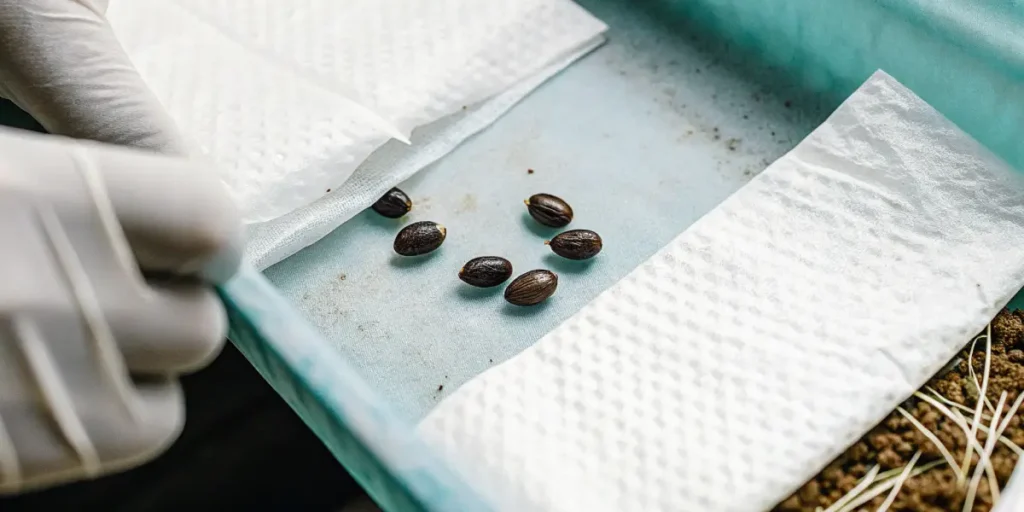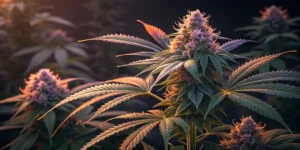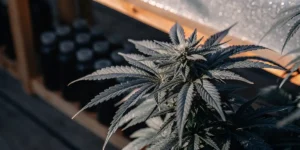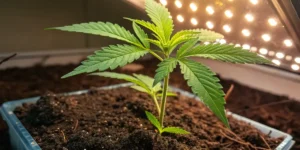Auto Duck, a distinctive cannabis strain renowned for its uniquely shaped leaves resembling a duck’s foot, is favored by growers for its stealthy appearance and ease of growth. This strain is particularly advantageous for beginners due to its resilient nature and automatic flowering trait. The key to successfully cultivating Auto Duck lies in understanding its specific requirements and providing optimal growing conditions. This guide will walk you through the process from seed selection to harvest.
Firstly, choose high-quality Auto Duck seeds from a reputable supplier. This ensures that the seeds are true to type and have high germination rates. Once you have your seeds, germinate them using a paper towel method or plant them directly into your growing medium, ensuring soil or a hydroponic setup with adequate aeration and drainage. Maintain a temperature between 68-77°F (20-25°C) to promote vigorous growth during the germination stage, typically lasting 3-7 days.
As seedlings emerge, transfer them to a larger pot if you’re growing indoors, or directly into soil if outdoors. Auto Duck thrives in a light, well-aerated medium, rich in organic matter. Indoors, ensure at least 18-20 hours of light per day using fluorescent or LED grow lights. Outdoors, plant them in a spot where they receive plenty of sunlight. Water regularly, but allow the soil to dry out slightly between watering to prevent root rot.
Auto Duck is an autoflowering strain, meaning it transitions from vegetative to flowering phase automatically after 3-4 weeks, irrespective of light cycles. During flowering, reduce nitrogen-rich fertilizers and switch to those with higher phosphorus and potassium. Regularly inspect for pests and diseases, although Auto Duck’s tough genetics generally offer resistance. Trimming the lower leaves can enhance airflow and light penetration.
Harvest Auto Duck 8-10 weeks from germination, when trichomes on the buds appear milky white with a hint of amber. Cut the plant at the base, hang upside down in a dark, well-ventilated space to dry for about a week, then trim and cure in airtight containers to enhance flavor and potency. With its stealthy growth characteristics and robust yields, Auto Duck provides an excellent return on your growing investment.
Auto duck Strain Overview: Traits, Effects & Genetics
The “auto duck” strain is a unique and innovative cannabis variety that has captivated growers and consumers alike. One of the most notable traits of auto duck is its distinctive leaf shape, which resembles a duck’s foot. This characteristic makes it ideal for outdoor cultivation, as it can easily blend into the surrounding flora, offering a natural level of stealth and discreteness. Auto duck is an autoflowering strain, which means it transitions from the vegetative stage to the flowering stage with minimal changes in light cycle, making it a convenient choice for both novice and experienced growers looking for a low-maintenance plant.
When it comes to effects, auto duck is known for delivering a balanced and manageable high. Users typically experience a gentle cerebral uplift combined with a soothing body relaxation. This strain is appreciated for its ability to gently ease the mind, making it suitable for both recreational and medicinal use. It’s often recommended for alleviating stress, anxiety, and mild pain due to its calming properties. The THC content of auto duck is moderate, ensuring that the high is not overly intense, which makes it an excellent choice for beginners or those who prefer a more subtle effect.
The genetics of auto duck are a carefully crafted blend that results in its unique traits and effects. It is derived from crossing strains that have been selected for their autoflowering nature and stealthy appearance. The genetic lineage typically includes the cannabis ruderalis species, known for its autoflowering properties, combined with other indica or sativa strains to achieve a balanced profile. This genetic background contributes to its resilience and adaptability in various growing conditions, making auto duck a reliable choice for growers seeking consistent results without compromising on quality or yield.
Optimal Environment to Grow Auto Duck Successfully
Auto Duck, a unique cannabis strain renowned for its odd-shaped leaves that resemble a duck’s footprint, offers discreet growing options, particularly appealing to those who emphasize privacy. To successfully cultivate this strain, it is imperative to establish an optimal environment that supports its unique characteristics. First and foremost, selecting the right location is crucial. Ideally, Auto Duck thrives in a controlled indoor setting where environmental variables can be precisely managed. However, it can also do well outdoors in mild to warm climates where the temperature ranges from 21°C to 26°C (70°F to 79°F).
When setting up an indoor grow space for Auto Duck, consider factors like lighting, humidity, and air circulation. This autoflowering strain requires substantial light for optimal growth, benefiting from approximately 18 to 20 hours of light per day during its entire lifecycle. Employ full-spectrum LED lights for the best results as they provide the necessary wavelengths that cater to both its vegetative and flowering phases. In terms of humidity, maintaining levels between 40% and 50% is ideal, as higher humidity can increase susceptibility to mold and mildew, potentially hampering growth.
Proper air circulation is another essential aspect of cultivating Auto Duck. Stagnant air can lead to an increase in pests and disease, so ensuring adequate airflow with and strategically placed fans is vital. Proper ventilation will also help in temperature regulation, keeping the environment in the optimal range. Additionally, hydroponics or soil with neutral pH levels around 6.0 provides a robust medium for nutrient uptake. Ensuring your soil or growth medium is fortified with essential macro and micronutrients can greatly enhance the robust development and yield from your Auto Duck plants.
Finally, monitoring the water supply is paramount for nurturing Auto Duck. This strain prefers a modest watering routine; overwatering can lead to root rot while underwatering may stunt its growth. Consider using pots with adequate drainage holes to prevent water from stagnating. By keeping these environmental factors well-balanced, growers can maximize the unique benefits of this remarkable strain, enhancing both its quality and yield without compromising its discreet nature.
Grow Room Setup for auto duck Plants
Auto Duck is a unique cannabis variety, renowned for its distinctive leaf shape, which resembles a duck’s footprint. This characteristic makes it less recognizable as cannabis, making it an excellent choice for those seeking discretion. When setting up a grow room for Auto Duck plants, several key factors must be considered to optimize growth while utilizing their natural stealth. Understanding these aspects will ensure you create an ideal environment for your plants to thrive.
Start by selecting a suitable space for your grow room. Auto Duck strains are autoflowering, meaning they automatically flower after a certain period regardless of light cycle changes. This characteristic provides growers flexibility in room choice, as managing light exposure is less critical compared to photo-dependent strains. Ideally, choose a space where you can maintain consistent environmental conditions—preferably a location where you can control temperature, humidity, and air flow effectively.
Lighting is a crucial aspect of any indoor grow setup. While Auto Duck does not heavily rely on light cycle manipulation, providing sufficient light intensity is vital. LED or HPS lights are recommended for their efficiency and ability to promote robust plant growth. Position your lights strategically to cover all plants evenly, ensuring they receive adequate illumination. Maintain a distance of about 18 inches from the plant canopy to prevent heat stress and maximize light absorption.
Temperature and humidity control are vital for the optimal growth of Auto Duck plants. Aim to keep the temperature between 70-85°F (21-29°C) during the day and slightly cooler at night. Humidity should be maintained around 40-60% during the vegetative stage and reduced to 40-50% during flowering to prevent mold and mildew. Investing in a reliable thermometer and hygrometer to monitor these parameters will aid in maintaining a stable environment.
Ventilation is another essential aspect of the grow room setup. Auto Duck plants, like other cannabis varieties, require fresh air circulation to facilitate photosynthesis and prevent the buildup of excess heat and humidity. Incorporate an exhaust fan for air exchange and an oscillating fan to help strengthen the plant’s stems by mimicking natural wind movement. This setup will improve plant health and reduce the risk of pests and diseases.
By paying attention to these factors when setting up your grow room, you create a supportive environment that leverages the unique traits of Auto Duck plants. Optimal lighting, temperature, humidity control, and ventilation will help you achieve a successful and discreet cannabis harvest.
Indoor Growing Tips for Auto Duck
Auto Duck is a unique strain of cannabis, famous for its distinctive webbed leaf morphology and its lower aromatic profile, which makes it an excellent choice for discreet indoor cultivation. When growing Auto Duck indoors, it is crucial to leverage its stealthy characteristics and ensure the environment supports optimal growth. One of the first considerations is to set up a controlled environment with proper lighting, as Auto Duck thrives under high-quality LED lights that provide a full spectrum. These lights not only mimic the sun’s natural rays but also contribute to efficient electricity usage.
Temperature and humidity are also vital components for successful indoor cultivation. Auto Duck prefers a consistent temperature range between 70-85°F (21-29°C) with some variance allowed during the night cycle. Maintaining relative humidity levels between 40-50% during the vegetative stage and reducing it to 30-40% during flowering can prevent mold and other moisture-related issues. It’s important to equip your grow space with a reliable hygrometer and thermostat so you can monitor and adjust conditions as needed.
Given its compact nature, Auto Duck is well-suited for smaller grow spaces, making it ideal for those with limited room. Utilize techniques such as Low-Stress Training (LST) to maximize light exposure and encourage even canopy growth without causing undue stress to the plants. Regular pruning may be necessary to manage its bushy foliage, improving airflow and light penetration, which can enhance bud development and overall plant health.
Another crucial aspect of indoor growing for Auto Duck is careful attention to nutrient management. Auto-flowering strains typically require a balanced nutrient blend that supports all stages of growth. Consider starting with a soil medium that contains the necessary compounds, and supplement with specific nutrients as needed, keeping an eye on pH levels to maintain nutrient availability. Watering should be consistent but moderate, as overwatering can lead to a host of problems, from root rot to nutrient lockout.
Monitoring the plant’s progress and staying observant to any changes can greatly improve your indoor cannabis cultivating experience with Auto Duck. By following these guidelines and adjusting based on your specific environmental conditions and plant responses, growers can optimize their yields and produce plants with robust, high-quality buds that showcase Auto Duck’s unique attributes.
Outdoor Growing Tips for auto duck
When embarking on cultivating Auto Duck outdoors, it is essential to understand its unique characteristics and growing requirements. Auto Duck is renowned for its stealthy appearance, which helps in avoiding attention from unwanted eyes. With webbed leaf patterns, it can easily be mistaken for typical non-cannabis plants, making it ideal for outdoor setups. Choose a location that provides abundant sunlight, as Auto Duck thrives in full sun exposure to maximize its growth potential. The strain is relatively hardy, yet ensuring a balanced environment will foster optimal development.
It’s important to consider the climate and seasonal timing when planting Auto Duck outdoors. While the strain boasts autoflowering properties, enabling it to flower independently of light cycles, it performs best in moderate climates. Aim to plant after the last frost to prevent damage; early spring or late autumn can be particularly favorable. The strain’s resilience makes it adaptable, but protection against extreme weather conditions can be beneficial. Constructing a simple shelter or using a greenhouse can help buffer against unexpected cold snaps or severe rains.
Soil preparation is crucial for successful outdoor growth. Auto Duck benefits from well-aerated and nutrient-rich soil, which fosters strong root development. A balanced mix of organic compost, perlite, and peat moss can enhance drainage and nutrition. Since the strain grows rapidly, regular feeding with appropriate nutrients will support its accelerated pace. A controlled regimen of balanced fertilizers, focusing on nitrogen in the vegetative stage and phosphorus and potassium during flowering, will provide all essential nutrients.
Lastly, pest control and monitoring can ensure healthy growth and abundant yields. While Auto Duck’s unique foliage may reduce its visibility to pests and humans alike, regular inspections are recommended to prevent infestations. Natural pest repellents or companion planting with pest-deterring species, such as basil or marigold, can offer organic protection. Frequent observation can catch potential issues early, ensuring the robust health of your Auto Duck plants throughout their growth cycle.
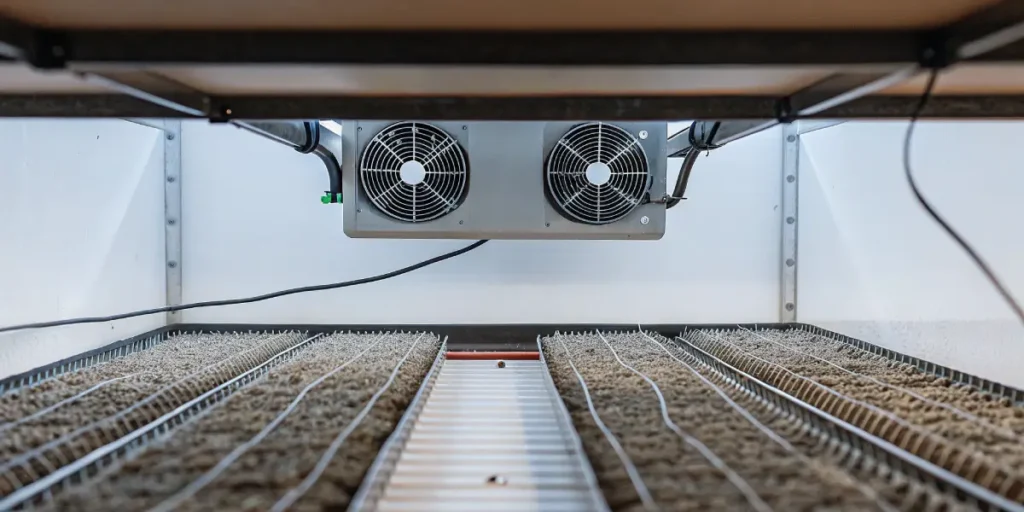
How to Germinate & Propagate auto duck
Auto Duck is a popular strain in the cannabis cultivation community, known for its unique leaf shape resembling a duck’s foot, which provides a level of stealth by making it appear less like traditional cannabis. Successfully germinating and propagating Auto Duck is key to taking full advantage of its resilient characteristics and achieving a prosperous yield. The first step in germination involves selecting high-quality seeds, ensuring they are mature and viable. Look for seeds that are dark, firm, and have a slight sheen plus, avoid seeds that are green or light in color as they may not germinate well.
To start the germination process, it’s recommended to use the paper towel method, which is both simple and effective. First, moisten a paper towel with distilled water, ensuring it is damp but not soaking. Place your Auto Duck seeds onto the towel, leaving enough space between each seed to prevent the roots from tangling. Cover the seeds with another damp paper towel to maintain moisture. Place the paper towels in a dark, warm area, ideally between 70-85°F (21-29°C), to provide an optimal environment for sprouting. Check the seeds daily, and keep the towels moist by spritzing with water if they begin to dry out.
Propagation of Auto Duck seedlings after germination requires care to ensure they develop into healthy plants. Once the seeds break open and small roots appear, typically within 24-72 hours, they are ready to be transferred into a growing medium. Gently transplant the germinated seeds into a small pot filled with a light soil mix, perlite, or coco coir to encourage root development. Plant the seed around half an inch deep, with the taproot facing down. Ensure the environment remains warm and humid, as these conditions support robust growth during this sensitive phase. With patience and careful attention, nurturing Auto Duck seedlings will result in a successful, bountiful grow.
Vegetative Stage
The vegetative stage is a crucial period in the development of your Auto Duck cannabis plants, which sets the foundation for robust growth and a bountiful yield. Auto Duck is a unique strain renowned for its distinct leaf shape and stealthy characteristics, making it an excellent choice for discrete cultivation. During the vegetative phase, which typically lasts around two to four weeks, your focus should be on providing the optimal environment and nutrients to encourage vigorous growth. Ensuring that your plants develop a strong root system and sturdy stems during this stage is vital for supporting the weight of flowers later on.
Lighting is an essential factor in the vegetative stage. Auto Duck plants require around 18 to 24 hours of light daily to maximize growth potential. High-quality grow lights, such as LEDs or high-intensity discharge lamps, are recommended for indoor growth, providing your Auto Duck plants with the full spectrum of light they need to flourish. Outdoor growers should ensure the plants receive adequate sunlight while protecting them from extreme weather conditions such as heavy rain or strong winds that may stress the plants and stunt growth.
Proper nutrition is equally important during the vegetative phase. Auto Duck plants thrive on a nitrogen-rich diet that promotes leaf and stem development. A balanced nutrient solution designed for vegetative growth should be applied according to the manufacturer’s instructions, ensuring the pH level of the soil or growing medium remains between 6.0 and 7.0 for optimal nutrient uptake. Be cautious about overfeeding, as this can lead to nutrient burn, which compromises plant health.
Additionally, environmental factors such as temperature and humidity play a significant role in nurturing your Auto Duck plants. Ideal temperatures range from 70°F to 85°F (21°C to 29°C) with humidity levels maintained between 40% and 60%. Good airflow within your grow space is crucial to prevent mold and pest infestations. Using oscillating fans can help maintain air circulation, simulating natural wind and strengthening the plants’ stems.
Finally, regular monitoring and maintenance are key to a successful vegetative stage. Inspect your Auto Duck plants daily for signs of stress or disease, and make necessary adjustments promptly. Pruning lower leaves and branches that receive less light can improve airflow and light penetration, promoting faster and healthier growth. With careful attention and optimal conditions, your Auto Duck plants will transition smoothly into the flowering stage, setting the stage for a rewarding harvest.
Flowering: What to Expect
Auto Duck is a unique and discreet variety of cannabis that is gaining popularity among growers for its distinctive leaf shape and potent yields. When it comes to flowering, Auto Duck offers a remarkable experience. Unlike traditional cannabis strains, Auto Duck has leaves that resemble those of a maple tree, making it difficult for casual observers to identify it as cannabis. This characteristic, combined with its auto-flowering nature, ensures that even novice growers can successfully cultivate this strain with minimal attention. Flowering typically begins around three to four weeks after germination, regardless of the light cycle, which simplifies the growing process significantly.
Expect the flowering period of Auto Duck to last about 8 to 9 weeks from when it starts, depending on environmental conditions and individual plant genetics. During this time, growers will notice rapid development in the plant structure. The plant remains relatively short and bushy, making it ideal for stealth grows and confined spaces. As flowering progresses, dense clusters of buds form, exhibiting a mix of earthy and pine aromas. This blend of scents is not only a treat for the senses but also further aids in maintaining discretion due to its mild nature compared to other cannabis strains.
As Auto Duck approaches harvest time, growers should monitor the trichomes closely for optimal potency. The buds will gradually become covered in a thick layer of resin, indicative of maturity and readiness for harvest. The leaves tend to remain strikingly green even in late stages, contrasting with the frosty trichomes. While it’s possible to harvest Auto Duck slightly earlier for a lighter, more uplifting effect, waiting until the trichomes are mostly cloudy with some amber will produce a more potent, relaxing effect. Timing the harvest correctly is crucial for maximizing the yield and quality of your crop.
Overall, cultivating Auto Duck is a delightful experience for growers of all levels. Its stealthy appearance, ease of growth, and dependable flowering timeline make it a reliable choice. The result is a versatile strain suitable for various uses, from recreational to medicinal applications. Expect a fulfilling outcome when growing Auto Duck, with yields that will satisfy both personal and shared enjoyment. Not only does it offer a short and lucrative growing period, but it also enriches growers with a rewarding sense of accomplishment by the end of its flowering cycle.
Fertilizers & Nutrient Schedule
Auto Duck is a unique cannabis strain known for its distinctive leaf shape and fast flowering time. One of the crucial factors to consider for a successful Auto Duck cultivation is its feeding regime. This strain tends to be less demanding in terms of nutrients compared to photoperiod strains, yet providing the right balance of fertilizers is essential for optimizing its growth and maximizing yield. An ideal feeding schedule involves understanding the plant’s life stage and tailoring the nutrient input accordingly.
During the seedling stage, Auto Duck plants require minimal nutrients. At this initial phase, it’s best to avoid feeding with fertilizers as the plant relies on the nutrients available in the seed. Instead, focus on watering with a pH-balanced solution to prevent nutrient lockout. As the plants enter the vegetative phase, a light feeding of a high-nitrogen fertilizer can be introduced. Providing a balanced nitrogen, phosphorus, and potassium (NPK) ratio supports vigorous growth and prepares the plant for flowering.
As Auto Duck transitions to the flowering stage, the nutrient focus should shift towards increased phosphorus and potassium levels to support bud development. It’s crucial to gradually transition to a bloom fertilizer with a lower nitrogen content during this phase. Over-fertilization can lead to nutrient burn, so it’s important to start with half-strength solutions and observe the plant’s response before adjusting the concentration. Incorporating micronutrients such as calcium, magnesium, and iron can also enhance plant health during this phase.
Throughout the growing cycle, regular monitoring and adjusting pH levels of the feed water is essential. Auto Duck plants thrive in a pH range of 6.0 to 6.5 for soil and slightly lower for coco or hydro setups. This helps ensure nutrient uptake efficiency. Implementing a flushing period of plain pH-regulated water in the final week before harvest can help in removing excess nutrient build-up, leading to cleaner and more aromatic buds. Thus, an effective nutrient schedule plays a crucial role in the successful cultivation of Auto Duck cannabis plants, helping growers achieve optimal yields and quality.
Pest and Disease Prevention for Healthy Cannabis Plants
Growing Auto Duck cannabis plants requires careful attention to pest and disease prevention to ensure robust and healthy growth. The unique leaf shape of Auto Duck, resembling a duck’s foot, offers some natural camouflage against detection, but it does not inherently deter common cannabis pests and diseases. Regular monitoring and preventive measures are essential from the germination stage through the entire growth cycle. Begin by selecting high-quality seeds from a reputable source, as healthy seeds are less prone to disease outbreaks.
One of the primary strategies in pest prevention is maintaining a clean growing environment. Routinely inspect your plants for any signs of insects such as aphids, spider mites, and whiteflies, which are known to infest cannabis plants. Implement neem oil sprays or insecticidal soaps as preventive measures to keep these pests at bay. Additionally, introducing beneficial insects, like ladybugs and predatory mites, can create a balanced ecosystem that naturally curbs pest populations without harming your plants.
For disease prevention, managing humidity and airflow in your growing area is crucial. High humidity levels can encourage the growth of mold and mildew, which are detrimental to Auto Duck cannabis. Ensure proper ventilation and use fans to promote air circulation, reducing the likelihood of fungal diseases. Monitor humidity levels with a hygrometer, aiming to keep levels between 40% and 60% during vegetation and slightly lower during flowering.
Moreover, proper watering techniques go a long way in preventing root rot, a common problem in cannabis cultivation. Water your Auto Duck plants just enough to keep the soil moist, but avoid waterlogging the roots. Employ containers with adequate drainage and use well-aerated soil to prevent overwatering issues. Additionally, rotating crops and clearing fallen debris will help eliminate habitats for pests and potential disease sources.
Harvesting & Drying auto duck the Right Way
Auto Duck is a unique strain known for its distinctive leaf shape and stealthy growth pattern, making it a favorite among growers who prefer discretion. Harvesting Auto Duck at the right time is crucial to ensure the optimal potency and flavor profile of the buds. The ideal harvesting window is typically between 70 to 75 days from germination. Look for the appearance of amber trichomes and a decrease in pistil visibility as indicators of readiness. These mature trichomes signify the peak cannabinoid levels, ensuring you capture the essence of your Auto Duck’s genetic potential.
When you decide it’s time to harvest, initiate the process by cutting down the plants at the base. It is best to do this early in the morning when the plant’s terpene levels are at their highest. Be gentle in handling the buds to prevent trichome loss, and consider using sharp, sanitized shears to make clean cuts. Once harvested, begin trimming away the larger fan leaves and then the smaller sugar leaves that surround the buds. Trimming facilitates faster drying and improves the overall aesthetics and smoke quality of the final product.
After trimming, the drying process begins, which is crucial in preserving the flavors, potency, and overall integrity of your yield. Hang the trimmed buds upside down in an environment that maintains a humidity level of around 45-55% and a temperature of 60-70°F (15-21°C). Ideal drying conditions will help avoid issues such as mold or mildew. Ensure good air circulation without direct fans on the buds to allow gradual and even drying. Typically, the drying phase should take about 7-10 days, leading to perfectly cured buds.
Once the buds are adequately dried, they should snap off the stems with ease. At this stage, it’s time to transfer them into airtight containers for curing. The curing phase requires opening the jars periodically for the first couple of weeks to release any built-up moisture and gases, a process known as “burping.” This stage allows the cannabis to mature further, enhancing the flavors and smoothness. Curing should ideally last for at least two weeks but can extend longer for more complex flavor development. Proper curing completes the journey of Auto Duck from seed to delicately aromatic, potent cannabis, ready for consumption or storage.
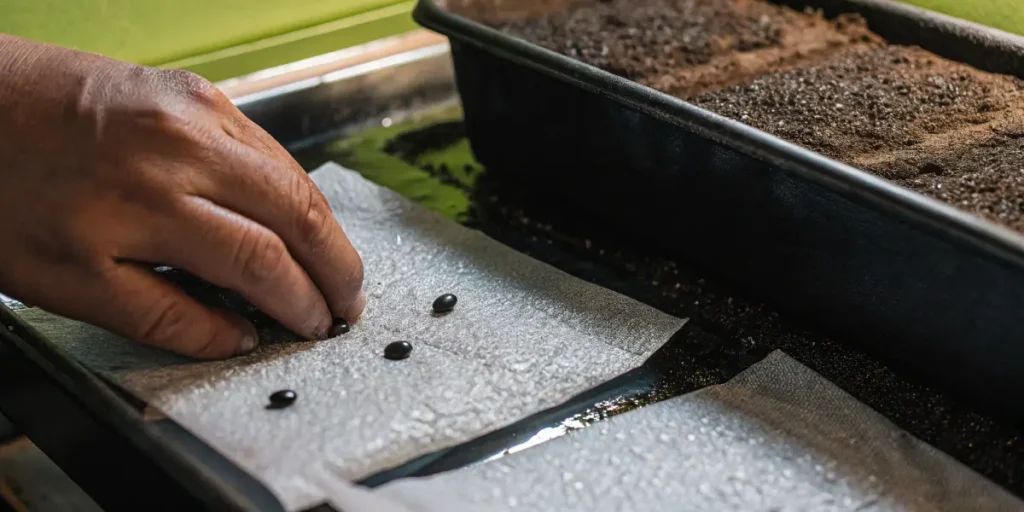
Auto duck Strain Type: Indica, Sativa or Hybrid?
Auto Duck is a unique strain in the cannabis cultivation world, renowned for its peculiar leaf shape and mysterious ancestry. In terms of strain classification, Auto Duck is often labeled as a hybrid. It was developed by Dutch Passion and is a cross between Frisian Duck and a robust autoflowering strain. This genetic blend brings together the characteristics of both Indica and Sativa, resulting in a balanced strain that appeals to a wide range of growers and consumers. As with many hybrid strains, Auto Duck aims to offer the best of both worlds, combining the relaxation typically associated with Indica strains and the uplifting effects of Sativas.
The Indica influences in Auto Duck are evident in its calming effects, which are more body-centric and can be quite soothing. This makes Auto Duck an excellent choice for those looking to unwind after a stressful day or seeking relief from physical discomfort. The plant’s growth structure also hints at its Indica lineage, as it tends to grow bushier and stockier, a trait that’s advantageous for those growing in spaces where height might be a limitation but width is not. The Indica influence contributes to its relatively short flowering time, which is a desirable trait for growers looking for a quick turnaround.
In contrast, the Sativa elements in Auto Duck bring a sense of mental clarity and creativity, enhancing the overall experience with an uplifting and energizing effect. This Sativa presence is also observable in its aroma and flavor profile, which are generally lighter and more citrus-forward, adding to the strain’s allure. While not as dominant as its Indica traits, the Sativa side of Auto Duck offers enough contrast to provide a well-rounded effect, making it suitable for daytime use without overwhelming lethargy. The synergy between Indica and Sativa in Auto Duck is a testament to the brilliance of modern cannabis breeding, offering an adaptable and multifaceted plant suitable for various preferences and cultivation conditions.
Why Grow Auto Duck? Key Benefits for Cultivators
Auto Duck is a unique choice for cultivators seeking a stealthy, easy-to-manage cannabis strain. Its distinctive leaves, which lack the traditional jagged edges of cannabis plants, make it less recognizable to onlookers. This characteristic gives growers an advantage in urban areas or where privacy is paramount. Furthermore, Auto Duck is an auto-flowering variety, meaning it transitions from vegetative to flowering phase based on age rather than light cycle changes. This trait enables cultivators to grow it at any time of the year, simplifying the planning process and offering more flexibility in growth cycles.
Another major benefit of Auto Duck is its resilience and adaptability, making it an excellent choice for beginners and experienced growers alike. Auto Duck thrives in various climates, which allows for outdoor cultivation even in atypical cannabis-growing regions. Its sturdy structure and resistance to pests and diseases reduce the need for intensive care, conserving resources and minimizing intervention. This hardiness ensures a potentially higher yield in unpredictable conditions, offering peace of mind to the cultivator.
Yield quality and convenience further make Auto Duck an attractive strain. Despite its stealthy appearance, Auto Duck can produce a generous yield, suited for both personal use and small-scale commercial operations. The auto-flowering nature of the strain leads to rapid growth cycles, often completing in just as little as 8 to 10 weeks from seed to harvest. This fast turnover allows growers to achieve multiple harvests in a single growing season, maximizing output and optimizing space utilization.
Potential Challenges When Growing Auto Duck
Growing Auto Duck, a popular cannabis strain known for its unique leaf structure and stealthy nature, presents specific challenges that cultivators should be aware of to ensure a successful harvest. One of the foremost challenges is managing the plant’s nutritional needs. As an autoflowering strain, Auto Duck has a fixed lifecycle that demands precise nutrient schedules. Overfeeding can lead to nutrient burn, while underfeeding may stunt growth or reduce yield. Striking the right balance is crucial, and cultivators need to carefully monitor the plant’s response to nutrient regimes.
A second challenge is optimizing the growing environment. Auto Duck thrives in a controlled setting where temperature and humidity levels are consistently managed. Sudden temperature fluctuations or exposure to extreme weather conditions can stress the plant, negatively impacting growth. Indoor growers need to ensure adequate ventilation and lighting while outdoor setups must shield the plants from harsh weather. High humidity levels during the flowering stage can also increase the risk of mold and mildew, so proper airflow is essential.
Pest and disease management is another significant hurdle when growing Auto Duck. Despite its resilience to some common cannabis pests, this strain is not immune to threats like spider mites or aphids. Regular inspection and prevention strategies, such as introducing beneficial insects or using organic pest deterrents, are recommended. Furthermore, diseases such as powdery mildew can arise if environmental controls are not maintained. Thus, maintaining cleanliness and preventing plant overcrowding can mitigate these risks.
Lastly, growers might face challenges related to the discrete appearance of Auto Duck. While its distinctive leaves make it less recognizable as a cannabis plant, this can lead novice growers to assume it requires less care than standard strains, which is not the case. Proper training and pruning techniques are essential to maximize yield and ensure the plants develop robustly without sacrificing their unique camouflaged characteristics.
Is Auto Duck Worth Buying? Here’s What You Need to Know
If you’re considering growing cannabis and are intrigued by the characteristics of the Auto Duck strain, you’re not alone. Auto Duck is a popular choice among cultivators due to its unique traits and practicality. Its name is derived from its distinctively webbed cannabis leaves which bear a striking resemblance to a duck’s foot, making it less recognizable to the uninformed eye. This natural disguise can be particularly advantageous for those seeking to cultivate cannabis discreetly, as it doesn’t draw attention like traditional cannabis leaves do.
Beyond its stealthy appearance, Auto Duck is also appreciated for its genetic lineage, stemming from the combination of the Frisian Duck and a Ruderalis strain. This autoflowering trait inherited from Ruderalis means Auto Duck doesn’t rely on specific light cycles to begin the flowering process, making it easier to manage especially for novice growers. Typically, Auto Duck plants will mature from seed to harvest in about 10 to 11 weeks. This quick turnaround time is exceptionally beneficial for growers looking for multiple harvests within a single growing season.
However, it’s important to consider the quality and quantity of the yield. Auto Duck tends to produce a respectable quantity of dense buds characterized by a moderate THC content, generally ranging between 7% and 15%. While this may appeal to casual users or those seeking a milder high, it may not satisfy those looking for the potency found in some other strains. Additionally, its terpene profile offers subtle earthy and fruity notes, making it a pleasant choice for those who prefer less intense aromas.
In short, Auto Duck is a worthy investment for growers prioritizing discretion and ease of cultivation. Its robust nature and resilience to pests provide an added advantage, making it particularly suitable for outdoor grows in less controlled environments. However, if your primary goal is to achieve high THC levels and maximum potency, you might want to explore other strains. Ultimately, whether Auto Duck is right for you will depend on your specific needs and growing conditions.
FAQs about Auto Duck
What is auto duck in audio production?
Auto duck, in audio production, is a technique used to automatically lower the volume of one audio track when another track is played. This is often used in radio broadcasting where, for example, the background music volume is reduced when an announcer speaks. The process is automated using a sidechain compression effect, which listens to the primary audio source (e.g., a voice) and ducks the other track accordingly, making the spoken words clearer to the audience.
How does auto ducking work?
Auto ducking works through the use of a compressor with a sidechain input. When a primary audio signal (called the sidechain signal) exceeds a set threshold, the compressor reduces the gain of another track. This creates space for the important audio to be heard, such as lowering background music during dialogue. By adjusting parameters like threshold, attack, and release, users can control how quickly and by how much the secondary track’s volume is reduced and restored, ensuring a balanced mix and seamless transitions between audio elements.
Where is auto duck commonly used?
Auto duck is commonly used in various fields, including radio broadcasting, podcasting, video production, and live events. In radio and podcasting, it is used to ensure that background music or effects don’t overpower spoken content. In video production, auto ducking helps maintain audio clarity when soundtrack or other audio layers compete with voiceovers or dialogue. Additionally, at live events, this technique aids in maintaining speech intelligibility by reducing ambient music or sound effects when a speaker is addressing the audience.
What are the benefits of using auto duck?
The primary benefit of using auto duck is to improve the clarity and intelligibility of speech in audio productions by automatically controlling the mix. It also enhances the listening experience by preventing audio masking, where important sounds are obscured by louder, less critical sounds. Beyond its technical merits, auto ducking saves time, as audio engineers and producers need not manually adjust levels in real time. This allows them to focus on other creative aspects of production while ensuring a professionally balanced sound.
What tools support auto ducking?
Many digital audio workstations (DAWs) and audio editing tools support auto ducking through built-in plugins or via third-party compression plugins that feature sidechain capabilities. Popular DAWs like Ableton Live, Logic Pro, and Adobe Audition offer sidechain functions that facilitate auto ducking. Furthermore, specialized tools like iZotope Neutron and Waves C1 Compressor provide advanced features for precise control over ducking parameters. Users can choose among numerous tool options to achieve the desired effects in their audio projects effectively.

